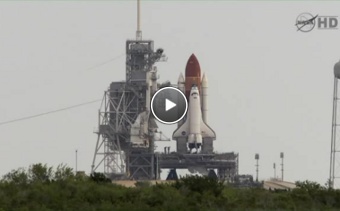Video of the week
Space shuttle Endeavour launchesThe space shuttle Endeavour launched from Kennedy Space Center on 16 May 2011 for its final mission, a flight to the International Space Station. It took with it the Alpha Magnetic Spectrometer (AMS-02), an experiment that will look for evidence of dark matter and antimatter. View CERN’s webcast of the launch, followed by explanations from AMS scientists. View the AMS installation on the International Space Station on 19 May 2011. |
In the News
-
from New York Times17 May 2011Dr. Goldhaber was director of the Brookhaven lab from 1961 to 1973, overseeing experiments there that led to three Nobel Prizes.
His most famous contribution to science’s basic understanding of how the universe works involved the ghostly, perplexing subatomic particles known as neutrinos. -
from LA Times16 May 2011Space shuttle Endeavour blasted to space – at last – on its final mission Monday, carrying a long-grounded $2-billion astrophysics device and a little bit of the hearts of thousands of space shuttle workers.
-
from physicsworld.com16 May 2011An instrument for detecting cosmic rays – and possibly even dark matter – has finally been lifted into orbit on board the space shuttle Endeavour.
-
from physorg.com13 May 2011Sadrozinski and Robert Johnson, professor of physics at UC Santa Cruz, used the same “silicon strip” detector technology for this project that they and other SCIPP researchers used to build detectors for major particle physics instruments, including the Fermi Gamma-ray Space Telescope and the ATLAS detector at the Large Hadron Collider (LHC) at CERN.
-
from Science Now12 May 2011Particle physics has fared less badly with a modest increase of 5% over the same 4-year period, but an increase in grants masks a dramatic drop in capital funding.
-
from Scientific American11 May 2011Researchers from a number of overlapping disciplines are awaiting a big boost from the world’s largest particle collider
-
from Nature10 May 2011Proof of the Higgs’ existence will not arrive as a bolt from the blue — instead, it will emerge slowly from weeks or months of data analysis, allowing ample time for each tantalizing step to be documented on blogs.
Copyright © 2025 ILC International Development Team




